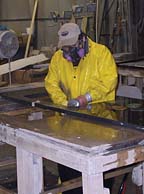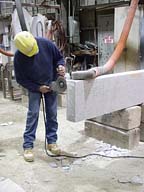

These days, it's not enough to just “take care†of your tools and equipment. Now, you have to also take extra care to insure that your workplace -- be it in the shop or on the jobsite -- is not only a “clean and tidy†place to ply your trade, but it also has to be a safe one as well. Gone are the days that the trades would joke about OSHA. Now, OSHA is a reality that we have to learn not only to live with, but also to benefit from.
Contrary to many popular opinions of the past, OSHA was not invented by the Federal Government solely to inflict pain and agony on the “little guy.†The true purpose of OSHA, is to help make a safer place for you, me and our customers.
Thanks to the trade publications, shows and organizations in our industry, many fabricators are able to see the light about OSHA. They are seeing the great benefit of being compliant with the many rules and regulations that have been established for the protection of their employees and their customers. Happily, many fabricators are now taking the time to learn how to be proactive when it comes to the subject of OSHA compliance and the ominous “OSHA Inspection.†It's no longer a question of if. It's now only when you'll be inspected.
This month's installment in no way is an “end all†to solving all of your company's needs to get into compliance with current OSHA standards. I thought this would be a helpful offering to all of our Stone World readers as a good start for their companies to compare themselves to the items on my “Top 10†list and see where they stood. The list is comprised from my visiting with fellow fabricators all over the U.S. over the last five years, and was not provided to me by any person from OSHA. My “Top 10†list is an informal compilation that I put together very un-scientifically, with an accuracy rating that I'd have to describe as “pretty good.†If you've had the misfortune to have been “written up†by OSHA recently, and your particular transgression isn't listed, please drop me a line, and let me know what happened to you in your situation. I am constantly updating my database so as to provide the most accurate information possible to our readers. My e-mail address is: kevinmpadden@cox.net, and my direct cell number is 480-993-6126.
In short, the purpose of this month's article has four parts:
1. Starting something to get into OSHA compliance is better than nothing at all.
2. I want to encourage my fellow fabricators to be proactive in finding where you need to get up to speed on OSHA compliance -- and get there quick.
3. I feel that the information here can help you establish a starting point for your compliance with OSHA regulations.
4. Most of all, I -- like many other folks in our great industry -- want to increase awareness as to what is coming your way from OSHA.
See if any of these apply to you, and if they do, you'll have some work to do ASAP.

The “Top 10†most common OSHA violations made by natural stone fabricators:
10. Lack of a written “HazCom†programThis is something that takes some time to get set up, but once it's in play, you are good to go. “HazCom†stands for Hazardous Communications. This simply means that all of your employees have the right to know, and you have to make sure that you have informed them -- and documented when you did -- as to what hazardous materials are in their work environment. An easy “rule of thumb†is to consider any substance that is in itself a hazard, such as hydrochloric acid or a slab of stone that, if cut dry, will release particles of dust into the air.
9. Missing electrical fittings, cords and protectors
This encompasses a lot of minor stuff, but the big ones are electrical extension cords that are frayed or have exposed wires that can cause a shock, broken or defective connection fittings to hand tools, and protective covers to exposed outlets in the shop. OSHA-approved extension cords will help ensure that you pass this one. By the way, it's a good idea to fit all of the electrical outlets in your shop as GFCIs (Ground Fault Circuit Interrupter). It's more expensive, but the chances of one of your employees getting a shock goes way down.
8. No guards on grinders and polishers
This is a charged issue with anyone that's had to polish an undermount sink opening, or had to cut an opening simply that cannot be done with a tool that has a guard on it. There are variances that OSHA will grant to certain trades (such as stone fabricators) when the presence of a protective guard will not allow the operator to perform the task that is trying to be accomplished. The Marble Institute of America will be working with OSHA in 2005 to address this issue in more detail for the benefit of the natural stone industry. (Stay tuned for more updates on this topic as they happen.)
7. No hard hats being worn
This is one that is more commonly found on jobsites. Many large residential builders have been proactive on the hard hat issue, because of the many head injuries that occur on their jobsites. Many fabricators insist that their install crews have their hard hats on at all times. The “rule of thumb†when it comes to the use of hard hats is this: when an employee or customer is in an environment that has the potential of having injuries occur from falling objects, protective headgear is required. Many companies now require ANY customer that goes into their production shop to take a tour or approve slabs, etc. to wear a hard hat. This is especially important when overhead handling equipment is in use, such as jib cranes, overhead gantry cranes or work that's being done on multiple levels. Hard hats should be either OSHA or DOT certified in order to be officially compliant.
6. No fall protection program
This is seen in any company where the work is not confined to ground level. If you are doing any kind of exterior panels, or work with a lift (such as a cherry picker) or scaffolding, you'd better have a basic fall protection program in place. This is very similar to the HazCom program, but is specific to anything that has to do with an injury or accident resulting from a fall.
5. No fire extinguishers available
This is probably most commonly seen not in a shop, but out on the jobsite. Did you know that you should have an “A-B-C†type fire extinguisher with every vehicle that is used for the course of your business? Most fabricators have a fire extinguisher in the shop, sometimes in the office, but do you know how many you are supposed to have based on the size of your facility? You also have to have proper signage showing where the fire extinguishers are; in the event they are needed to put out a fire.
4. No OSHA “Form 300†on file
Any work-related injury must be documented on the OSHA “Form 300,†and a copy has to be kept on file in your establishment -- somewhere that anyone can review it for any reason. Additionally, there are certain posters that MUST be posted in your establishment - in all languages that apply to your employees. This is called “Right To Know;†information that every employee should know exists and can review on demand. These posters are available from the Federal and State Governmental agencies, as well as many private companies that have these available in languages other than English.
3. No “MSDS†forms on file
This has been a very confusing area for many fabricators, because we tend to think that an MSDS (Material Safety Data Sheet) only applies to dangerous or hazardous items. On the contrary, the official standard is that an MSDS applies to anything that is a solid, a liquid or a gas. That pretty much narrows it down to any matter on God's green earth.
2. Lack/improper storage of hazardous/flammable materials
This one takes a lot of work to get into compliance, because of the different chemicals and products that can pose a hazard to employees and/or can ignite, causing a fire. Did you know that you can store flammable materials, such as acetone, alcohol, gasoline and other burnable liquids ONLY in DOT (Department Of Transportation)-approved containers, and those containers have to be marked with the name of the substance that's in them? And there's only so much you can store in your shop, and then, it should be kept in a fireproof storage cabinet. There are a lot of technical regulations that you have to be aware of and implement in order to be within the law on this subject.
1. Lack of proper PPEs worn by employees
PPE's (Personal Protective Equipment) are, in our industry, the holy triad: ear, eye and respiratory protection. I know that it's a pain to have to wear protective eyeglasses when you're trying to wet-polish an edge, but it's something that has to be done. Many guys like me (that have been at this trade for over 20 years) now have hearing loss because they didn't think they needed to wear earplugs or earmuffs when they used their 4-inch grinders all day long. Lots of people can't sing in their church choirs anymore, because of all of the dust they've breathed in over the years -- all because they were too macho to wear protective respiratory gear like a simple dust mask or a respirator.
Of course there is much more to consider, such as having an EAP (Emergency Action Plan) posted at conspicuous places in your shop and office to aid if there's a fire, earthquake, explosion or other disaster. It is also required to maintain boundary markers at all electrical boxes. Did you know that you have to keep the areas in front of and to either side of an electrical fuse box clear? It's 3 feet in all directions to be precise.
There are many more OSHA facts that you can learn. One way to start is to visit OSHA's Web site via the Internet at www.osha.gov and start digging for yourself.


